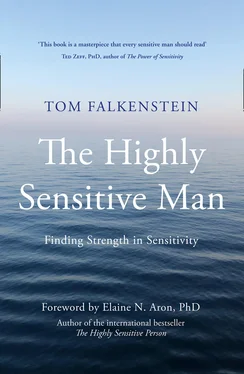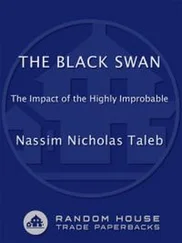In this chapter, I want to begin by dealing with the question of how men are really doing in Western societies and to bring in some opinions and studies from the United States, Europe, and beyond. Because this is a book about highly sensitive men, I think it’s important that we clearly outline the social context in which men are currently living. This chapter is therefore, in the first instance, a plea for greater diversity in masculinity—a diversity I believe we need and that could represent a possible solution to our so-called “crisis of masculinity.” I’m also convinced that highly sensitive men have a key role to play in this long-overdue emancipation of men from classic stereotypes of masculinity, precisely because they challenge and therefore expand our image of the “typical strong man.”
Is Masculinity in Crisis?
Though it was founded in 1901, it took the renowned British Psychological Society until 2014 to dedicate a whole issue of its journal, The Psychologist , to the psychological health of men. 5This followed a series of discussions among politicians and in the media about an apparent “crisis of masculinity” that was raging in the country. 6But this recent interest in the male psyche and in male identity isn’t just a European phenomenon. In the United States, too, the term toxic masculinity , describing a particularly unhealthy form of male identity, has increasingly been doing the rounds. 7Indeed, one of the most influential psychologists of our time, Philip Zimbardo—who gained international notoriety for his 1971 Stanford Prison Experiment—devoted his last book to the male identity crisis. 8Toxic masculinity has also been addressed by British author Jack Urwin in his book Man Up: Surviving Modern Masculinity , 9and in Germany, the magazine Der Spiegel published a column dedicated to the topic, titled “It’s a Boy.” The author, Margarete Stokowski, wrote, “There’s an English term, ‘toxic masculinity,’ used to describe a form of masculinity based on dominance and violence that rejects emotions. It’s a problem that boys and men are constantly told that ‘real guys’ don’t cry, are highly, almost animalistically sexual, and crush anything that stands in their way. It’s a problem for both men and women. This is the form of masculinity that we need to address. Just because it’s widespread doesn’t mean that it’s natural.” 10
So it seems everyone is talking about a “crisis in masculinity.” It is a crisis marked by men’s insecurity about their role in society, their identity, their values, their sexuality, their careers, and their relationships. 11At the same time, academics are telling us that “we know far less about the psychological and physical health of men than of women.” 12Why is this?
Michael Addis, a professor of psychology and a leading researcher into male identity and psychological health, has highlighted a deficit in our knowledge about men suffering from depression and argues that this has cultural, social, and historical roots. If we look at whether gender affects how people experience depression, how they express it, and how it’s treated, it quickly becomes clear that gender has for a long time referred to women and not to men. According to Addis, this is because, socially and historically, men have been seen as the dominant group and thus representative of normal psychological health. Women have thus been understood as the nondominant group, which deviated from the norm, and they have been examined and understood from this perspective. One of the countless problems of this approach is that the experiences and specific challenges of the “dominant group,” in this case men, have remained hidden. 13
As we have discussed, though, this is finally beginning to change, with men’s psychological health beginning to become part of our public discourse. What in the past was taken for granted is now being questioned. And perhaps it is precisely this questioning and the identification, analysis, and redefining that this entails, that is being understood as a crisis in masculinity and as a challenge to the “stronger sex.”
How Are Men Doing?
While it is true that a higher percentage of women than men will be diagnosed with an anxiety disorder or a depressive episode, the suicide rate among men is much higher. In the United States, the suicide rate is notably higher in men than in women. According to data from the Centers for Disease Control and Prevention, men account for 77 percent of the forty-five thousand people who kill themselves every year in the United States. In fact, men commit suicide more than women everywhere in the world. 14Men are more likely to suffer from addiction, 15and when men discuss depressive symptoms with their doctor, they are less likely than women to be diagnosed with depression and consequently don’t receive adequate therapeutic and pharmacological treatment. 16
Young men are currently less academically successful at secondary school than young women. The number of men applying to university is now lower than the number of women applying, 17and a far higher number of men drop out. 18Men are also far more likely to be arrested. Ninety-three percent of people in prison are men. 19These are startling numbers.
Even in wealthy industrialized nations, men die on average around five to ten years earlier than women. Although the causes are potentially manifold, medical opinion increasingly points to lifestyle, behavior, and environment, rather than biological difference, as being the most likely reasons behind this disparity between the sexes. Indeed, Dr. Thomas Perls, a professor at Boston University’s School of Medicine, has been researching life expectancy for many years, and he believes that around 70 percent of this difference in life expectancy is due to lifestyle, behavior, and environment, with the remaining 30 percent being attributed to genetic or biological factors. 20The conviction that lifestyle and behavior, rather than biological difference, are the reasons behind men dying earlier than women is also backed up by Dr. Marc Luy’s “cloister study.” His research shows that life expectancy among monks and nuns, who live in a nearly identical environment with a very similar lifestyle, is almost exactly the same. What’s more, the monks who took part in the study lived on average around four years longer than men in the general population. Luy believes that the reasons for this difference are rooted in the monastic lifestyle, which is based on a daily routine that is consciously organized and highly regulated, a healthier lifestyle, and lower levels of stress. 21
If behavior and lifestyle do indeed have such a decisive impact on men’s psychological and physical health compared with simple biology, then this raises the question, What is influencing men’s behavior and the sometimes self-destructive lifestyle that results from it? The answer, to a very great degree, appears to lie in the socialization of men and the “masculine” values and norms that men consequently internalize and then express in their behavior.
When Is a Man a Man?
If we take a moment to ask ourselves what makes a man “manly,” that is to say, what the social expectations for men are, we will likely come up with different answers. I would assume, however, that many of us would name several classic, traditional masculine attributes: physical strength, stamina, emotional control, stoicism, independence, heterosexuality, drive, bravery, dominance, risk-taking, competitiveness, professional success, and sexual performance. In other words, we would probably describe, more or less, the typical image of the “strong man.” I suspect that words such as sensitive , emotional , delicate , or compassionate would come up less often.
Читать дальше












